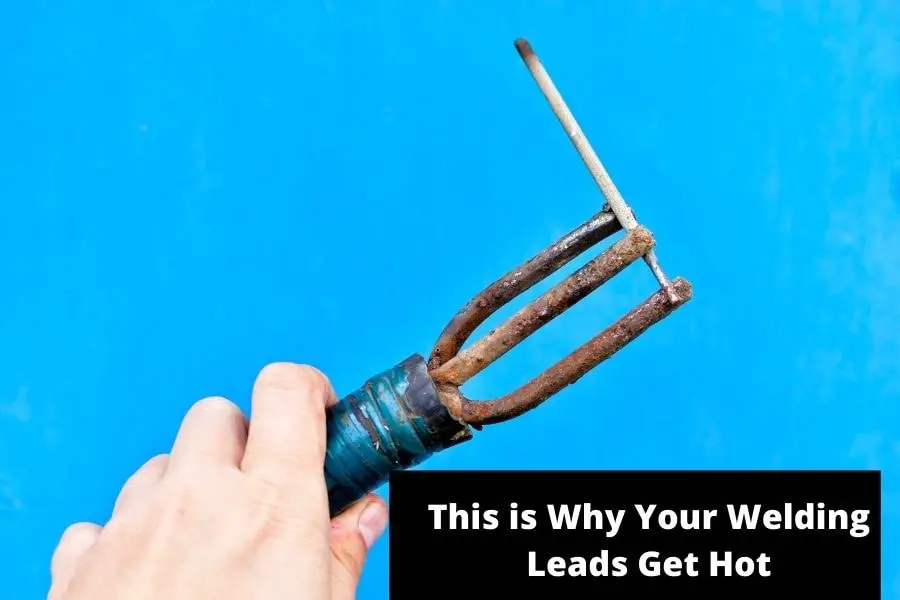Welding is no easy task. It tasks a lot of skill and practice and a fair amount of knowledge of what you are doing. One of the things that throws many welders off their game is the leads getting hot. This can happen to you with a machine that you have been using for a while. So, why does it happen? Well, if you have ever wondered that then this is why your welding leads get hot.
Welding leads can get hot when there is excessive resistance and for improper or inadequate grounding. This might lead to increasing the output for when you are using it to weld. Another reason can be because of the cable being the incorrect size.

If that got you interested to know more about it, I have some good news for you. That is not the end of it. There are some more things to it. So, let’s get into some of the details then.
Why is Your Welding Leads Getting Hot?
Welding is used for joining two pieces together (duh). It gives you a durable connection and is no wonder why it is used in many projects and constructions as well.
A filler material is also used to make the connection. One type of welding is ARC welding which uses an electric arc to melt the work material and create a weld. This is where a welding lead comes in. They are also called welding cables.
These are primarily electrical conductors that are wrapped inside some sort of rubber jacket. The rubber jacket is insulating, of course. Depending on the current (whether high or low), you will use a longer or a shorter lead or cable.
The benefit of using a longer cable for high current is it gives you less resistance. There will be two types of leads that will connect to the machine. One will go into the welding machine itself to the electric holder. Another one will connect to the work piece. This one is called the ground lead.
As you might imagine, when you are getting hands-on with a welder, the welding lead getting too hot can be very uncomfortable and also dangerous. This is a sign that something is wrong.
Do not worry though. The problem can be diagnosed very easily. The problem might be one of two. The cable length or grounding.
As I have already mentioned, depending on whether you are using high current the cable needs to be picked out properly. If you have a shorter cable than required, you could face excessive resistance. That might lead to the welding lead getting hotter. See, what I did there?
Jokes aside, it is important to choose the right size welding cable or lead. The length of the cable affects the voltage drop of the machine. Generally, you would need to dial up the voltage to compensate for the resistance.
With the right cable size and length, voltage resistance can be mitigated for the most part. Another reason could be that you have improper grounding. If your work clamp isn’t grounded properly heat can be a problem too.
Bad grounding will also give you increased resistance which will, in turn, cause heat. If the work clamp isn’t fastened properly, make sure to fix it right away. Taking care of these two things should mostly get rid of the excessive heating problem.
Poor grounding and improper cable size are perhaps the two primary reasons for leads overheating due to increased resistance. But there can be other reasons as well. It goes without saying that it is important to make sure the cables are of good quality.
If the welding leads are frayed or damaged, there can be high resistance as well. Any deformations like the cable being flattened or just general wear and tear could be another reason for this.
Sometimes you just need to get the brand-new cable to make things work. Nothing has an infinite life span and welding leads are no different in that case.
What is the Best Way to Place Welding Leads?
Let me touch on how to best place your welding leads to combat resistance. Knowing this will help you make sure you follow the best practices when placing your leads. You will also have proper grounding.
Step 1 – Ground Placement
The ground clamp should be connected to the work piece via the work lead. Make sure this is in its proper position. There are two ways to do this. You can either use a metal work table and connect the clamp to the table. Or you can connect it directly to the work piece as well. It depends on which one works for you and the piece you are working with.
Step 2 – Hooking Up the Leads
The next step is to hook up the leads to the welder itself. The electrode cable should be connected to the positive terminal of the machine and the work lead connects to the negative terminal. Some modern machines will have a switch to change the polarity.
This is there because sometimes you can swap the connections without any problems. It will depend on whether you are using DCEN, DCEP or AC connection.
Step 3 – Plug in the Welding Machine
Lastly, all you need to do is to connect the welding machine. There is one particular thing you need to pay attention to here. Make sure to set up the voltage and current in the right setting according to your welding application. Follow these steps and you should be ready to make masterful welds in no time.
Best Practices While Welding
There are some things that every welder should know of and practice while operating a welder to ensure nothing goes wrong like the leads getting too hot. Here are some of them:
- Safety First – Always make sure you take safety as your number one priority. Wear all the protective gear and most definitely welding gloves. A welding helmet is also a must. I also insist on having some sort of supervision if you are new to welding.
- Project Planning – Planning out your project beforehand will ensure you account for all variables. Nothing is worse than being halfway in your welding process and realizing it isn’t the right kind of welds or you made a mistake.
- No Substitute to Quality – Frankly, a quality welding cable has no substitute. Always make sure to get high-quality cables to prevent yourself from headaches later on.
- Double Check the Cables – Check if the cables are straight and there are no kinks or obstructions. Straighten the cables and then start welding away. Bent cables are not your friend here. So, always double-check if the cables are alright.
- Proper Sized Leads – I already mentioned, this is one of the reasons you can experience overheating. Check to see whether you are using the proper lead size before you start welding.
Conclusion
There you have it then. These are the reasons why your welding leads get hot. As you can see, the fix isn’t that difficult and you can easily identify the problem once you know what to look for. Make sure to have optimal resistance and your machine will work like a charm.
If the welding cables are too old, it might be best to just replace them. In case the problem persists, you need to call your machine manufacturer to see if there is something you are missing. Hope this article was able to help you out with your welding troubles. Thanks for reading.
